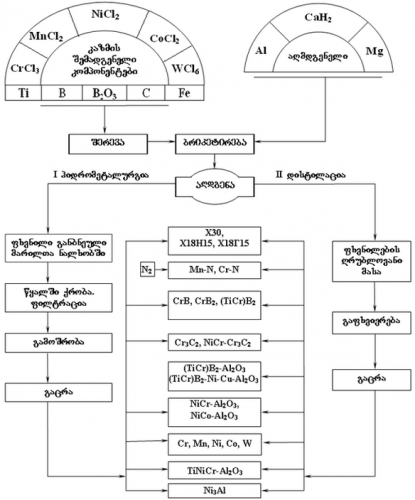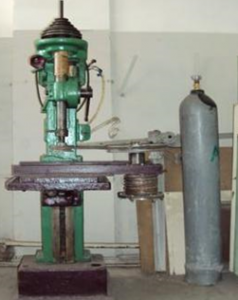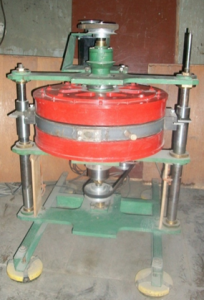Restoring geometric size of worn out details and creating a layer with special properties on their surface is one of the pressing issues for multiple use of these details. The most common method of creating the cover layer is covering the surfaces of metal details with electrodes made from powders with necessary properties using methods of electric-spark alloying, plasma spraying or electric-arc welding. The advantage of these methods is high adhesion with the main metal and relative simplicity of technology.
In order to get corrosion resistant, heat resistant and wear resistant coatings it is recommended to use composite powders, which consist of hot corrosion resistant metal based and dispersed particles.
One of the promising methods of powder manufacturing is a joint metal-thermal recovery of halogens or oxides of related metals with the participation of powdery particles of reinforcing, strengthening phase.
Major scientific directions of the laboratory are:
1. Manufacture of metal, metal-ceramic and composite powders, research of their physical-mechanical and technological properties;
2. Production of electrodes from received powders for arc welding and electric-spark alloying, restoration-strengthening of metal surfaces with wear resistant, heat resistant and corrosion resistant coatings, research of their exploitative properties and determination of their area of use;
The main directions of scientific topic are:
1.1. Research of manufacturing process of ultra-dispersive metals, compounds, alloys, dispersion-strengthened composite powders (Cr, Ni, Co, W, X30, X18H15, X18Г15, CrB2, TiNiCr, Ni3AI, CrB2-AI2O3, (TiCr)B2- AI2O3, NiCr-Cr3C2) and other powdery materials with improved properties, development of principal technological scheme , manufacture of test batches and research of their technological properties;
Technological scheme of manufacturing powders with different destinations from chloride-oxide charge with metal-thermal restoration is shown on picture 1.
1.2 Manufacture of NiCr-ZrO2/Y2O3; NiCr-La2O3; TiC-WC-NiCr; Co-Ni-Cr; Ti-Ni-Co; NiAI-TiB2 and other types of composite powders in high energy mills (pic2) by mechanical alloying.
Optimal parameters of mechanical alloying of powders inside high-energy attrition type mill constructed and built by us: Rotation frequency of the attritor axle 330-420 rev/per min (range 105-1020 rev/per min); Loaded balls’ (Titanium ШХ15 steel) diameter is 6 mm; Ratio of balls and loaded charge mass is 18:1; the duration of alloying is 20-30 hours;
Dispersion-hardened powdery composite materials have been obtained in high energy attrition mill by means of mechanical alloying. Specifically NiCr-ZrO2/Y2O3; NiCr-La2O3; TiC-WC-NiCr; Co-Ni-Cr; Ti-Ni-Co; NiCr-Cr2O3; NiAI-TiB2 etc.
Approximately 60 % of particles of the alloyed composite powders vary from 2 to 8 micrometer; 25-30 percent is in the range of 10-16 micrometer, and only 7-10 percent makes up the 20-28 micrometer fraction. The hardening nano-scale compounds (oxides, carbides, intermetallic compounds) are evenly distributed in the matrix and significantly increase its strength.
1.3. Creation of B4C, TiNi, TiC, NiAI, WC-Co and other types of powders in magnetic-jet mill rotating at high speed (8000 rev/per min) (pic.3) by deep mechanical dispersion of metallic and ceramic powders (not more than 5 micrometer).
Dispersion is done in the magnetic field rotating at high speed (N=8000 rev/per min) at the expense of particle collision in conditions of motion of cylindrical bodies (0,9-1,1 mm). 350-1500 micrometer fraction powders are being dispersed for 30-60 minutes up to 5 micrometer and additionally their pollution by outside impurities is impossible.

Pic1. Process diagram of obtaining various application powders through metal-thermal reduction from chloride-oxide feed.
|
|
|
|
Pic. 2. High-energy attrition mill |
Pic. 3. Mechanical dispersion of metallic and ceramic powders in magnetic-jet mill |
2. Processing standards and normative documentation about powder composite materials and their manufacturing technology.
3. Preparation of analytical material about wide range of scientific and technological problems in the field of materials science, marketing, research of market conjuncture and analysis of its development.
The ways of implementation and the expected final results:
-
Optimal technological parameters will be established by studying process’ kinetics of Aluminum thermic restoration of chloride-carbide charge and by implementation of processed technological cycle composite powders strengthened with ultra-dispersive high-melting-point compounds will be created ;
-
The research of technological properties of created powders will ascertain: Granulometric composition, bulk weight, picnometric density, fluidity, particle form, parameters of powder pressing and sintering. In conjunction this data determines optimal conditions for constructing press forms intended for work pieces or electrodes and dosing of powders;
-
Method of compacting test-powders will be selected. Electrodes (4X5X50 mm) will be created for electric-sparkle alloying and alloying of test-details’ surfaces will take place on arc welding aggregates (using powdery electrodes). The research of metallographic and some of exploitative properties of covered samples will determine their area of use;
-
Manufacturing process of new type of composite powders will be processed by using non deficient and inexpensive starting charge materials, by reducing energy costs not less than by 15% compared to the existing methods, through application of simple hardware and non-waste process ;
-
Electrodes manufactured from new powders with high physical-mechanical and exploitative properties will be used for restoration-strengthening of wear and heat resistant details’ surfaces by electric-sparkle, plasma or electric arc method. The growth of exploitation properties of coatings by 20% is expected;
-
In order to restore-strengthen surfaces of military purpose details working in heat resistant and wear resistant conditions, the classification will be determined for those which will be subordinated to: a) alloying by electric-sparkle method (with covers up to 100-200 micrometer) b) restoration of details unsuitable for further exploitation (2,5-3 mm damaged) using plasma or electric-arc methods ;
Commercial interest:
- Manufacturing dispersion-strengthened composite powders, compounds, alloys, wide ranging homogenous powder metals with improved physical-chemical and mechanical properties on the basis of pure and inexpensive non deficient raw material by alumothermal restoration of chloride-oxide charge
- Abrasive, heat-firm and wear resistant properties of ceramic in metal-ceramic compounds are effectively combined with plasticity and viscosity of metal. Manufacturing powders with properties of this kind is impossible with other known methods.
- Significantly reduced power consumption (by 25-30%) due to high exothermicity of the process and its short duration at relatively low temperatures
- Simplicity of technological cycle tailored installations;
- Ensuring non-waste technology and addressing environmental issues;
Analysis of the market:
The wide variety of costumers of new products made on the base of powdery materials manufactured in the laboratory are machine engineering and electronic enterprises, aviation and metallurgy factories, oil processing companies, stone processing and mining-enriching enterprises, jewelry, individual labor places etc.
At present metal powder materials and products made from them are not manufactured in Transcaucasia republics and Turkey, but the demand on the products manufactured by the method of powder metallurgy grows every year. This demand is satisfied by foreign companies. In particular, “Sandvik Coromant” (Sweden), PEFERD and Titex Plus (Germany), PRAMET (Czech Republic), SGS Tool Company (USA), MITSUBISHI CARBIDE (Japan), “Saturn» (Russia), “Toreztverdosplav” (Ukraine) and others.

